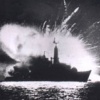Being only seven when the Mary Rose was lifted from the seabed, I didn’t understand the historical significance of this event – although I did obviously appreciate the time out from lessons to watch a special news programme about it.
In 1982 the culmination of years of hard work and one of the most complicated and costly maritime archaeology undertakings came to fruition. The team in charge of the salvage operation brought the hull of the ship out of the water in Portsmouth harbour on a lifting frame, watched by spectators and Prince Charles alike. The hearts of the team who had worked on the salvage operation for the past three years must have been in their mouths as the Mary Rose finally made it safely to shore.
When Henry VIII succeeded his father, Henry VII in 1509, he inherited the royal ships from him as well. Already under his command were impressive war ships such as the Sovereign and the Regent, but intimidation by the great navies of Scotland and France meant that the new King started strengthening his fleet straight away, with Portsmouth becoming the hub of the campaign.
The Mary Rose began her service for Henry in 1510; her name has been attributed to Henry’s sister Mary Tudor, although there is no proof in existence to support this claim and it’s just as possible that it came from the name given at the time to the Virgin Mary, ‘The Mystic Rose’. By 1520 the precursor to today’s Royal Navy was up and running: King Henry VIII‘s Navy Royal.
In 1512 the Mary Rose saw her first real action. She was taken into battle against the French and Breton navies in the English Channel, led by Lord High Admiral Sir Edward Howard, whilst England’s Spanish allies took on other French ships in the Bay of Biscay. After Howard’s 18-strong fleet seized 12 Breton ships, the English then went on to raid and burn villages in Brittany.
After the Mary Rose’s journey back across the Channel, the King met with the fleet and instructed them to head out to Brest, where they were involved in a gun battle with the French and Breton ships once again. Many French sailors were killed and more areas of France raided before heavy storms drove the ships, the Mary Rose included, home to England. After a race with the other English ships in 1513 Howard chose her as the fleet’s flagship in a new battle near Brest but this time they were up against a reinforced French navy and Sir Howard was killed during an attack on a galley ship.
A new Lord Admiral was assigned and in the summer of 1513 the Mary Rose was called into a less dangerous role; Scotland and France became allies against the English and she joined a fleet which moved troops up to Newcastle for their onward transportation to Northumberland and the Battle of Flodden. The ship took part in other battles with the French in the next couple of months, but the war was drawing to a close, and she wouldn’t be used in any further conflicts until 1522 when the two countries again faced each other. The Mary Rose then took troops over to France, sailing back to Dartmouth once the Breton port of Morlaix had fallen to the English.
She was then kept as a reserve ship until 1535, where it is thought she was rebuilt to be stronger and possibly had holes cut into her hull for large guns, which would have had watertight covers when the weapons weren’t in use.
In 1545 a French fleet of 128 ships assembled in the estuary of the Seine, with the intent of dispatching their troops into England via the Solent. They arrived there in July, to be met by the English navy - consisting of 80 ships, including the Mary Rose – who had amassed at Portsmouth harbour. The initial fighting was long range and both sides survived mostly intact, with King Henry even dining on the flagship Henry Grace a Dieu on one occasion.
Several days later, however, the Mary Rose was to be finally defeated after bombardment by the French. Differing accounts from the time make it difficult to get a clear picture of exactly how she went down but down she went, with the lives of several hundred English sailors being taken at the same time. Divers tried to retrieve the Mary Rose in the weeks that followed, but she had sunk fast into the seabed and they were ultimately unable to raise her.
And the seabed is where she stayed for nearly four and a half centuries. In 1836 a bronze demi cannon was discovered by divers at the site of the shipwreck, but it wasn’t until 1965 when the first serious attempt to find Henry VIII’s ship got underway. ‘Project Solent Ships’ was set up by Alexander McKee, a military historian and diver, in conjunction with the British Sub-Aqua Club’s Southsea branch. The general aim of this collaboration was to locate all wrecked ships within the Solent’s waters, but McKee’s ultimate goal was to find the Mary Rose.
The team used sonar to scan the seabed, and it was this which found a shape embedded into the bottom of the strait. In 1968 divers began to excavate the area with water jets and dredgers; the pieces of timber they found led them to believe they were on the right track. In May 1971 three frames from the port of the Mary Rose were discovered, followed by planking and deck beams. In 1978 the divers found that two of her decks had survived almost intact and the decision was made to attempt the excavation of the ship in one piece.
The Mary Rose Trust, with Prince Charles as its president, was created in 1979 for this purpose with hundreds of full time staff and volunteers involved in the many tasks involved, including archaeologists, administrators, fundraisers and over 500 divers. A salvage vessel anchored at the wreck site allowed shift working, which in turn sped up the project. All artefacts found were analysed and documented, before being kept in controlled conditions.
Work on the raising of the Mary Rose, between 1979 and 1982, took the equivalent of 12 man years under the water – a total of approximately 28,000 dives. Many alternative ways of raising the hull of the Mary Rose were pondered, but eventually the team decided on using a purpose built frame to lift it up. Tog Mor, an enormous crane which floated on water, would raise the frame, which would have wires connected to bolts made of steel that would be passed evenly through the ship’s structure.
And so, on 11 October 1982 (whilst children from all round the country were no doubt sitting cross legged in front of school televisions) the operation got under way; a steel frame was lowered into position above the Mary Rose and secured onto the hull, before hydraulic jacks started the delicate operation of manoeuvring the ship up an inch or so. This ensured it was clear of the silt – and therefore the suction – which had been holding it down. It was then gently placed down into a second frame which was sat on the seabed nearby; finally it was ready to be taken up to the surface. The crane slowly began to lift up – taking the strain of the entire 570 tonnes that it needed to raise clear of the water.
Airbags surrounded the ancient timber - making sure it was protected from any knocks - as the Mary Rose emerged from the sea for the first time in 437 years. She was placed on a waiting barge and towed to Portsmouth’s Royal Naval Base, where the remains were protected in foam and polythene and ceaselessly sprayed with water to stop the wood from drying and bacteria growing.
In the following years the team continued to work on restoring King Henry’s once proud warship; titanium replacement beams were used to fill in any gaps in the decks, with the last one being fitted in 1993 and the water spray was later switched to polyethylene glycol – sealing the wood with wax. In 2013 the spraying stopped and the hull was left to dry out.
19,000 artefacts from the Mary Rose were discovered during the rescue and the processes used to preserve them were at the peak of marine archaeology practice. They pioneered the techniques that are used today to restore items that have been trapped in water. Further objects have been recovered in the Ministry of Defence funded dives that took place between 2003 and 2005 and regular dives still take place at the wreck site to monitor the remaining parts of the ship that are still down there.
The restored hull of the Mary Rose, plus many artefacts, can now be visited in its dedicated museum in Portsmouth.










Do You Remember The Raising of the Mary Rose?
Do You Remember The Raising of the Mary Rose?